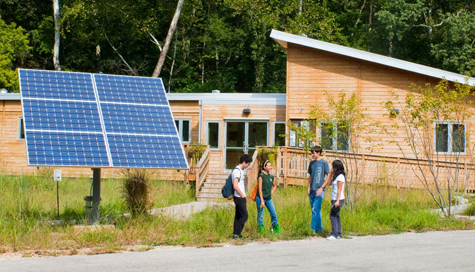Building at Tyson Research Center ties with another to be first to meet Living Building Challenge
Oct 12, 2010
The Living Learning Center just became one of the first “living buildings” in the world, a title that requires net zero energy usage and net zero wastewater production over the course of a year. For a high-resolution photo, click here.
The call came in to Kevin G. Smith, PhD, associate director of the Tyson Research Center at Washington University in St. Louis, from Jason McLennan, CEO of the International Living Building Institute (ILBI).
McLennan was calling to tell him that Tyson’s Living Learning Center had achieved the world’s first full certification under the Living Building Challenge run by the ILBI.
The challenge is widely recognized as the world’s most rigorous green building performance standard.
Smith texted the good news to Deborah S. Howard, who had worked closely with Smith on the project. “I’m so happy,” said Howard, special assistant to the executive vice chancellor of administration Henry S. Webber, repeatedly. Her jubilance outran her ability to put words to the news.
A second building, Omega Center for Sustainable Living in Rhinebeck, N.Y., simultaneously won full certification. A third building, Eco-Sense, a private residence in Victoria, British Columbia, was awarded partial certification.
More than 70 projects worldwide are actively pursuing Living Building certification, hoping to be the first to qualify.
Founded in 2009 by the Cascadia Green Building Council, the ILBI is a non-governmental organization dedicated to the creation of truly sustainable built environments around the world.
Launched in November 2006, the Living Building Challenge was developed by McLennan and the Cascadia Greeen Building Council and is now managed by ILBI.
To achieve certification, a project must:
- generate all of its own energy through clean, renewable resources;
- capture and treat its own water through ecologically sound techniques;
- incorporate only nontoxic, appropriately sourced materials; and
- operate efficiently and for maximum beauty.
To achieve ‘Living’ status, all program requirements must be met and proven through a full year of operation, culminating in a third-party audit.
Read the entire article at The Source.


